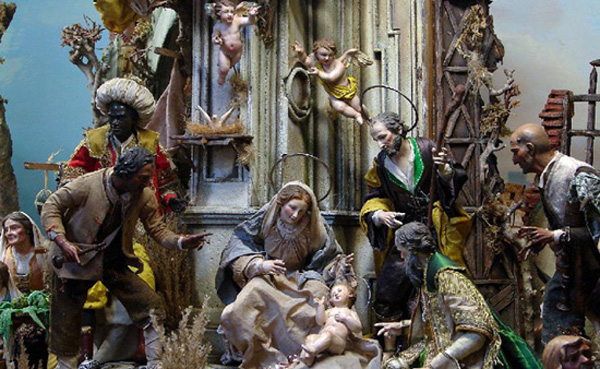Ambiences and Tendencies
 |
 |
 |
 |
 |
 |
 |
Christmas in Italy, Germany & Brazil;
Three Types of Contemplation

If we imagine an elaborate nativity scene in certain regions of Italy, we see all the figures have very emphatic attitudes: the Child Jesus lying in the manger extending his arm to Our Lady. She leans toward her Divine Son in an attitude of profound tenderness, but a lively tenderness that manifests itself in expressive gestures. It is as if the artist's aim was to have managed to have Our Lady and the Child-God convey such an impression that someone could say, “All that is missing is for them to speak!,” For to speak and express oneself constitutes the pinnacle of achievement in this scene.
St. Joseph also, who is nearby (and who naturally plays a more modest role in the dialogue between the Blessed Virgin and the Divine Child as he is only the legal father) takes a position that, while just short of speaking, seems about to weep or to smile, according to one’s interpretation, but it also is extremely expressive. One sees that, according to this conception, religious emotion should be manifested with a great vivacity, which in turn should be expressed by thoughts and words. And such thoughts must be lively, and expressed in warm and emphatic terms.

The German idea of Christmas night is the exact opposite of this. To be truly sacral, Christmas night must awaken in souls a profound impression, which is common to all peoples. But for the German mentality, this profound impression, by the very fact of being profound, should not be too communicative because it is situated very deep in the soul. And the best outward manifestation of this spirit is silence, recollection and calm.
While for some the word and the gesture are the height of expression, for others the climax of expression is a form of silence and inaction that reveals unsuspected depths of the human soul; and by their very silence, they indicate the soul’s impotency to express everything that it ponders. They indicate a state of spirit less exclamatory and more meditative. One could say that it is a recollected, almost philosophical or theological attitude.
This calm, which is not of a scientific type, is profoundly tender; a tenderness which indicates such a great affection that the person prefers to be silent rather than to speak. In this way, while some display an eloquence of words and gestures, others manifest, so to speak, the eloquence of silence and recollection. These are two different positions.
Which one is better? I understand that the Italians have their own position in this matter, and so do Germans.
What would be the Brazilian attitude? It is one that understands and appreciates both positions. This is the typical Brazilian way of being and it is what I feel in myself: a perfect understanding of both Italians and Germans.
As a Brazilian, I would speak less than Italians but be less quiet than Germans, particularly since by blood I am a Brazilian with the loquacity of the Northeast.
These are regional varieties by which God wants to be worshiped by all peoples. So it is not for us to choose one but rather to contemplate the beauty of all the various ways.

Posted December 20, 2017
______________________
______________________








